

Added XX September 2019
Districts (Intros)
| ~~~ Toledo District ~~~ | ~~~ Stann Creek District ~~~ | ~~~ Cayo District ~~~ | ~~~ Orange Walk District ~~~ | ~~~ Corozal District ~~~ | ~~~ Belize District ~~~ |
| Day 1 | Day 2 | Day 3 | Day 4 | Day 5 | Day 6 | Day 7 | Day 8 | Day 9 | Day 10 | Day 11 | Day 12 | Day 13 | Day 14 | Day 15 | Day 16 | Day 17 | Day 18 | Day 19 | Day 20 | Day 21 | Day 22 | Day 23 | Day 24 |
25 May 2014, Sunday - Yok Baluum Cave and Uxbenka Mayan Site, Toledo District, Belize
As we finished breakfast the tour operator, Bruno Kuppinger, arrived (and in true German fashion, ahead of schedule) and told us what we had in store for us today. 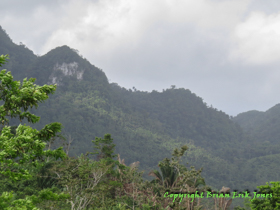 He knew a professor conducting research in a nearby cave called Yok Baluum that has an ancient Mayan ceremonial offering bowl in it. The professor and a number of his students will be arriving at Tranquility Lodge tonight to do some work in Yok Baluum cave. Bruno said the cave is normally not open to the public, but he was able to arrange for us to go.
He knew a professor conducting research in a nearby cave called Yok Baluum that has an ancient Mayan ceremonial offering bowl in it. The professor and a number of his students will be arriving at Tranquility Lodge tonight to do some work in Yok Baluum cave. Bruno said the cave is normally not open to the public, but he was able to arrange for us to go. 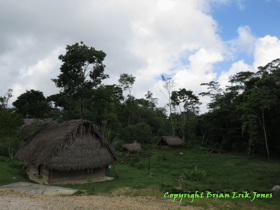 While we had requested bird and wildlife centric tours, it sounded interesting, and we didn't want to seem ungrateful for the special tour, so we happily agreed.
While we had requested bird and wildlife centric tours, it sounded interesting, and we didn't want to seem ungrateful for the special tour, so we happily agreed.
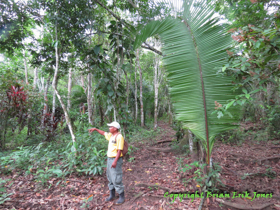 After a brief introduction to Belize at the lodge, Bruno drove us to the Mopan Mayan village of Santa Cruz, where we met our guide, Jose, and his "assistant", Enrique. Both Jose and Enrique are Mopan Maya from the village. Jose is a licensed tour guide, while I gathered that Enrique is not, but Bruno always has two guides on every tour in case of emergency. If I understood correctly, Enrique was the chairman of the village council! His jobs for the day though, other than to act in an emergency, were to clear the overgrown jungle path with his machete and to carry our lunches and some personal items that Shan and I would have happily carried but that Bruno thought was too much for us to carry, such as sandals for the stream crossing we had ahead of us. It was a bit strange to have some village dignitary as our sandal porter and machete wielder, but we didn't ask questions.
After a brief introduction to Belize at the lodge, Bruno drove us to the Mopan Mayan village of Santa Cruz, where we met our guide, Jose, and his "assistant", Enrique. Both Jose and Enrique are Mopan Maya from the village. Jose is a licensed tour guide, while I gathered that Enrique is not, but Bruno always has two guides on every tour in case of emergency. If I understood correctly, Enrique was the chairman of the village council! His jobs for the day though, other than to act in an emergency, were to clear the overgrown jungle path with his machete and to carry our lunches and some personal items that Shan and I would have happily carried but that Bruno thought was too much for us to carry, such as sandals for the stream crossing we had ahead of us. It was a bit strange to have some village dignitary as our sandal porter and machete wielder, but we didn't ask questions.
As the four of us departed down the trail to the cave, Bruno departed, and would pick us up at the end of the day. Within 15 minutes of starting out, the rain started, and it continued to rain off and on for most of the rest of the day. We were hiking down a jungle track used by the villagers and Enrique certainly put his machete to use in making the way less narrow for us. The trail was steep in places, and due to the muddy, slick conditions we were often on the verge of falling on our butts. It was rather slow going. The mud did create conditions that allowed us to see that a small cat, probably a Margay, had traveled the trail not too long before us.
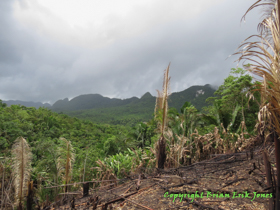
 Early on, Jose told us a saying that we found ourselves repeating often throughout the day and throughout our entire trip: "If you're not here, you're nowhere." We understood it to mean not only "where I am is so amazing that it's not worth being anywhere else," but also "live in and appreciate the moment."
Early on, Jose told us a saying that we found ourselves repeating often throughout the day and throughout our entire trip: "If you're not here, you're nowhere." We understood it to mean not only "where I am is so amazing that it's not worth being anywhere else," but also "live in and appreciate the moment."
A short distance down the trail, Jose pointed out a patch of jungle that was slightly more open than the rest of it. There were small red-leaved trees scattered throughout the clearing, but there was nothing else to distinguish this particular patch of ground from any other part. Jose explained to us that this was the village cemetery. 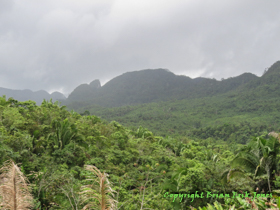 The Maya (at least of Santa Cruz) do not use handmade grave markers for their interred loved ones, but instead plant one of those red-leaved plants and rely on memory to remember where their loved ones are buried. The process of burying someone is interesting.
The Maya (at least of Santa Cruz) do not use handmade grave markers for their interred loved ones, but instead plant one of those red-leaved plants and rely on memory to remember where their loved ones are buried. The process of burying someone is interesting. 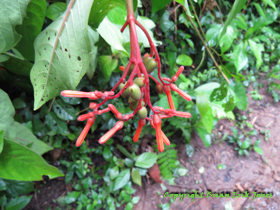 An official goes around the village and determines who will help dig the hole and perform other tasks to help with the burial of the body. It's sort of like jury duty, I suppose, but no one tries to get out of it. If you are called upon to help, you happily oblige.
An official goes around the village and determines who will help dig the hole and perform other tasks to help with the burial of the body. It's sort of like jury duty, I suppose, but no one tries to get out of it. If you are called upon to help, you happily oblige.
It became clear early on that Jose wasn't well versed as a birding guide, not that it would have likely mattered with all the rain and Enrique at the front of the group slashing through the jungle with a machete scaring any wildlife away. So Shan and I both resigned ourselves to just enjoying the beautiful jungle and learning about the Mayan culture from Jose. We probably wouldn't have seen much in the rain anyway.
As a side note, we brought rain gear, but it was so warm and humid that we opted to be wet from rain instead of being wet from sweating inside our rain gear. 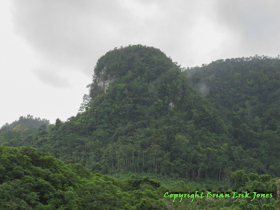 This scenario played out all through Belize. In fact, the only time any of our rain gear got used was when Shan was cold on our flight from Dallas to Tucson returning home and she wore my rain coat to keep warm. All that we ever protected was our camera equipment, so we should have saved space and weight in our luggage and left the rain gear at home.
This scenario played out all through Belize. In fact, the only time any of our rain gear got used was when Shan was cold on our flight from Dallas to Tucson returning home and she wore my rain coat to keep warm. All that we ever protected was our camera equipment, so we should have saved space and weight in our luggage and left the rain gear at home.
At one point we had to cross a fairly wide, but shallow river. This was why we were told to bring sandals today. 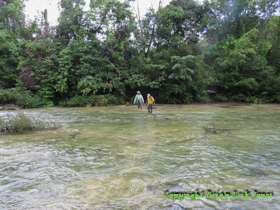
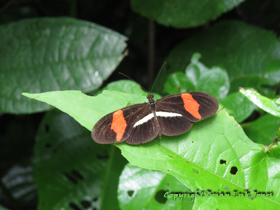
|
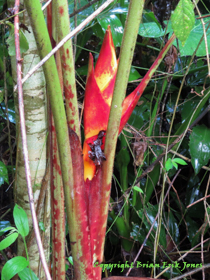
|
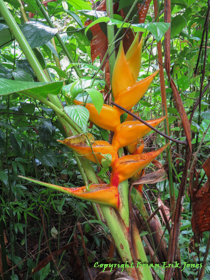
|
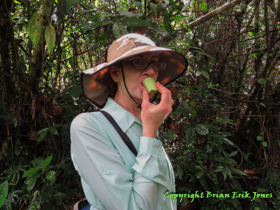
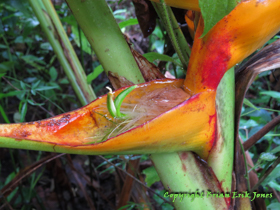
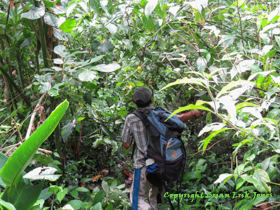 As we hiked, Jose also told us about some of the plants we saw and how they were used by the Maya. One particularly noteworthy one was a bamboo-like plant he called gorilla cane. He explained that it is used to quench thirst (he also called it jungle Gatorade), and that it also has the medicinal property of curing bladder infections. He then broke a piece off, peeled away the outer layer, and we all had a bit. To me, it tasted most like a green apple. It was quite tart with a hint of sweetness, and it did have a refreshing, uplifting quality to it. Since returning home, I haven't been able to figure out what the real name of the plant is.
As we hiked, Jose also told us about some of the plants we saw and how they were used by the Maya. One particularly noteworthy one was a bamboo-like plant he called gorilla cane. He explained that it is used to quench thirst (he also called it jungle Gatorade), and that it also has the medicinal property of curing bladder infections. He then broke a piece off, peeled away the outer layer, and we all had a bit. To me, it tasted most like a green apple. It was quite tart with a hint of sweetness, and it did have a refreshing, uplifting quality to it. Since returning home, I haven't been able to figure out what the real name of the plant is.
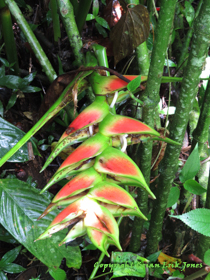
|
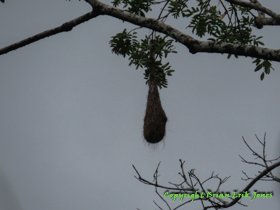
|
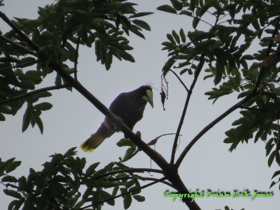
|
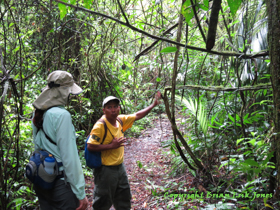
|
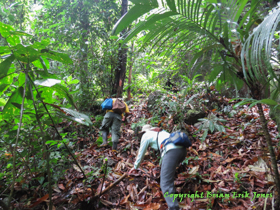
|
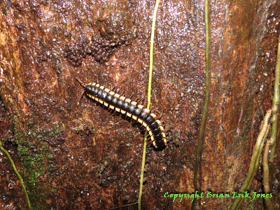
|
After hiking a couple of hours we reached the base of the hill below Yok Baluum Cave. There was no real trail to the entrance so we just had to scramble up the steep, slippery hillside to the entrance. After a bite to eat we donned our helmets and headlamps and headed in to the cave.
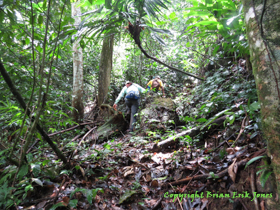
|
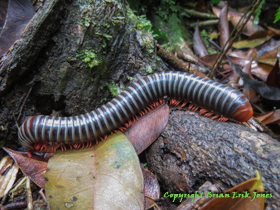
|
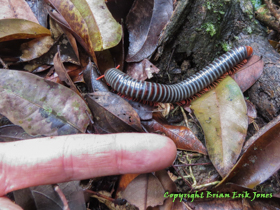
|
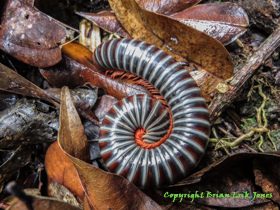
|
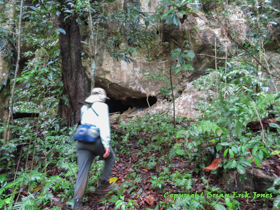
|
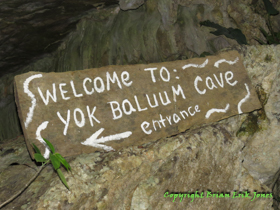
|
There was a bit of crawling to do at the beginning, but it wasn't as tight as we were lead to believe. I suspect they're not used to people who have done real caving so Jose's description was a bit of an overstatement. When he said it was really tight, we were expecting to barely fit through, but while it was a definitely belly crawl, it was at least 15-18 inches high. The rest of the cave required some scrambling, but no crawling.
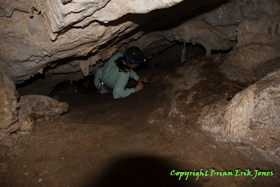
|
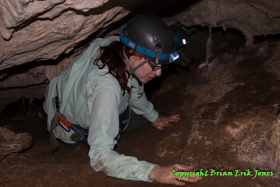
|
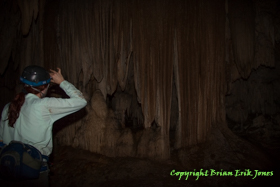
|
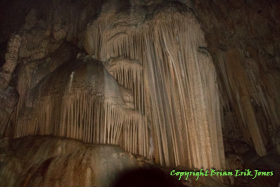 We then made our way through the cave towards a second cave opening that we would eventually exit from, though we didn't know this until we got there. Since the whole trip was a surprise to us, we had no idea how long we would be in the cave. It turned out that we were in there quite a while. It was definitely the largest non-commercial cave I've been in, with many rooms and passages, most of which we didn't explore. The cave had some really nice formations, but it lacked the color and sparkle that a lot of Arizona caves have. Along the way we encountered some of the instrumentation that had been put in the cave to take scientific measurements, though we weren't told what they were measuring.
We then made our way through the cave towards a second cave opening that we would eventually exit from, though we didn't know this until we got there. Since the whole trip was a surprise to us, we had no idea how long we would be in the cave. It turned out that we were in there quite a while. It was definitely the largest non-commercial cave I've been in, with many rooms and passages, most of which we didn't explore. The cave had some really nice formations, but it lacked the color and sparkle that a lot of Arizona caves have. Along the way we encountered some of the instrumentation that had been put in the cave to take scientific measurements, though we weren't told what they were measuring.
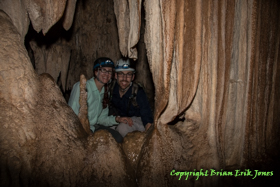
|

|
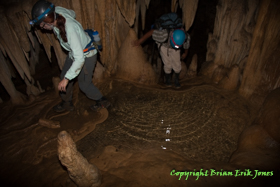
|
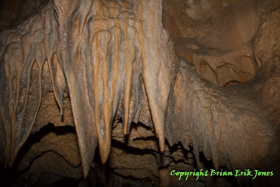
|
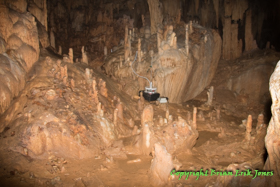
|
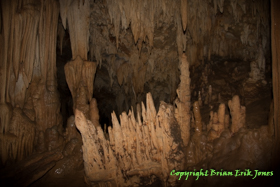
|
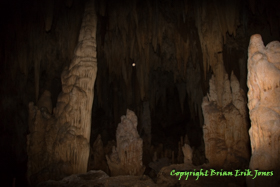
|
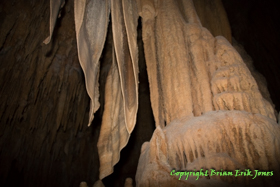
|
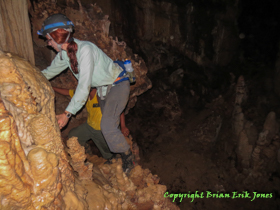
|

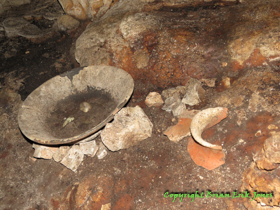 After what seemed like a couple of hours, we reached the Mayan offering bowl. The bowl was dated to around 740 A.D. and is still used today by Mayans in the area when they want to pray for rain, abundant crops, and the like. Part of the ritual is to burn various items in the bowl. The bowl was very simple, but also very intimate and personal, and as such, it resonated deeply with Shan and I. We would see far grander and exciting Mayan artifacts latter in Belize, but it was a humbling privilege to see the simple offering bowl. It felt like making a deep connection to the past and to the native culture. "If you're not here, you're nowhere."
After what seemed like a couple of hours, we reached the Mayan offering bowl. The bowl was dated to around 740 A.D. and is still used today by Mayans in the area when they want to pray for rain, abundant crops, and the like. Part of the ritual is to burn various items in the bowl. The bowl was very simple, but also very intimate and personal, and as such, it resonated deeply with Shan and I. We would see far grander and exciting Mayan artifacts latter in Belize, but it was a humbling privilege to see the simple offering bowl. It felt like making a deep connection to the past and to the native culture. "If you're not here, you're nowhere."
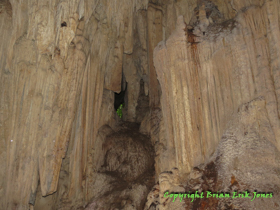 Unfortunately, by the time we got to the ceremonial bowl, it was well after noon and we were both hungry and in need of relieving our bladders, so while I would have loved to have spent more time just absorbing the aura of the offering bowl, we soon headed to the nearby cave opening where we had a snack before hiking back to Santa Cruz.
Unfortunately, by the time we got to the ceremonial bowl, it was well after noon and we were both hungry and in need of relieving our bladders, so while I would have loved to have spent more time just absorbing the aura of the offering bowl, we soon headed to the nearby cave opening where we had a snack before hiking back to Santa Cruz.
Shan's hypoglycemia was definitely kicking in at this point. Since we had no idea how long the hike and cave experience was going to be, we expected to be back in the village by lunch time and we didn't come prepared for her to eat lunch so late. On the hike out I could tell that she was really struggling due to low blood sugar, but she marched on admirably. One thing that motivated her was the thought of getting some more gorilla cane. When we finally got to it, Jose gave her a nice big piece. While not the perfect solution, it helped her a great deal and the rest of the hike became more enjoyable for her.
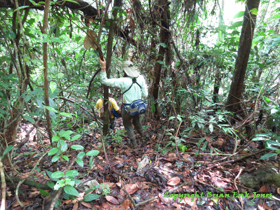
|
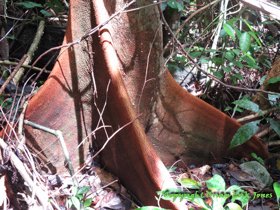
|
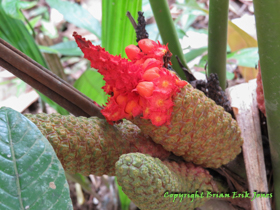
|
On the way back, Jose explained a bit about the construction of the thatched roof huts in the village. Houses are constructed by the community on a "you thatch my house, I'll thatch yours" basis. When someone wants to build a new thatched roof building they call on others to help build it. Anyone asked to help first goes out to the jungle and collects 24 palm fronds then brings with him to the job site, so the helpers are supplying materials (albeit free ones) as well as labor. The group can build a structure in a matter of days that, if well-constructed, can last up to 10 years before it needs maintenance. And all nearly for free from resources found in the forest and a little help from friends and family. How many hours does the average American or European work to pay for his or her house? Thinking about this made it hard to feel that modern society is so superior.
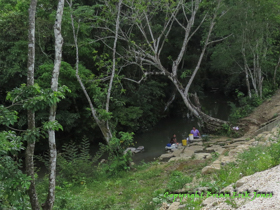
|

|
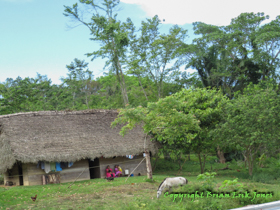
|
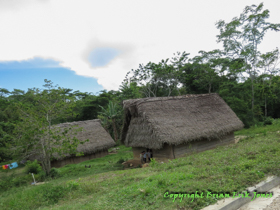
|
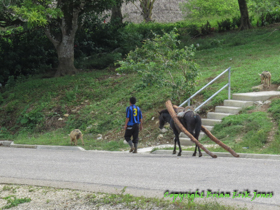
|
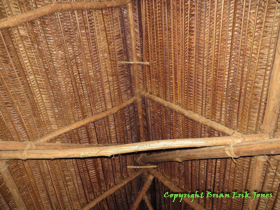
|
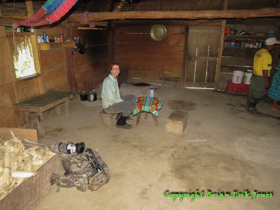
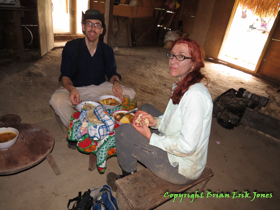 It was almost three o'clock by the time we got to Jose's house, where his wife, Hilda, had prepared for us an amazing meal called caldo. Caldo is a traditional Mayan meal that is often eaten at celebrations like weddings, anniversaries, and the like. Enrique returned home so we ate with just Jose while Hilda served the food.
It was almost three o'clock by the time we got to Jose's house, where his wife, Hilda, had prepared for us an amazing meal called caldo. Caldo is a traditional Mayan meal that is often eaten at celebrations like weddings, anniversaries, and the like. Enrique returned home so we ate with just Jose while Hilda served the food. 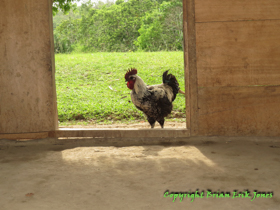 We were seated on tiny chairs around a tiny table in a hut with a thatched roof, a mud floor, and a huge pile of corn in the corner. The only other things in the building were the open hearth cooking space, a low table in the crude (and intentional) shape of a turtle for making tortillas, and Hilda's cookware. It was a very special moment that Shan and I will always treasure. "If you're not here, you're nowhere."
We were seated on tiny chairs around a tiny table in a hut with a thatched roof, a mud floor, and a huge pile of corn in the corner. The only other things in the building were the open hearth cooking space, a low table in the crude (and intentional) shape of a turtle for making tortillas, and Hilda's cookware. It was a very special moment that Shan and I will always treasure. "If you're not here, you're nowhere."
While we ate, the family chickens kept walking up to the open doorway and looking in, only to be shooed away by Jose or Hilda. It was pretty comical. They were like little kids wanting to see what was going on and get in on the action.
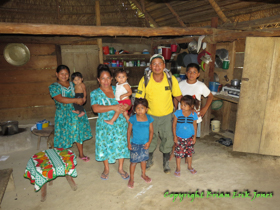 After lunch, Jose brought out cups of a traditional Mayan chocolate drink that was not nearly as sweet as what we call hot chocolate, but it had more nuanced, richer flavor. After lunch, Shan asked to see some of the crafts that Hilda and Jose's sister, Atacalia had made. She ended up buying a small basket and three turtle shaped "baskets," all woven out of jippy jappa, a type of palm found in the area.
After lunch, Jose brought out cups of a traditional Mayan chocolate drink that was not nearly as sweet as what we call hot chocolate, but it had more nuanced, richer flavor. After lunch, Shan asked to see some of the crafts that Hilda and Jose's sister, Atacalia had made. She ended up buying a small basket and three turtle shaped "baskets," all woven out of jippy jappa, a type of palm found in the area.
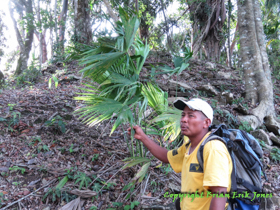 The original plan had been to briefly visit the Mayan site of Uxbenka after lunch then go to the Rio Bravo Falls to swim and do whatever else you do there, but we were behind schedule so we could only do one or the other. Though Uxbenka isn't considered a top Mayan site (or even much of a destination at all, since it hasn't been excavated), we opted to visit it instead of Rio Blanco, in part because Jose predicted that the Rio Blanco would be pretty muddy due to the rain all day.
The original plan had been to briefly visit the Mayan site of Uxbenka after lunch then go to the Rio Bravo Falls to swim and do whatever else you do there, but we were behind schedule so we could only do one or the other. Though Uxbenka isn't considered a top Mayan site (or even much of a destination at all, since it hasn't been excavated), we opted to visit it instead of Rio Blanco, in part because Jose predicted that the Rio Blanco would be pretty muddy due to the rain all day.
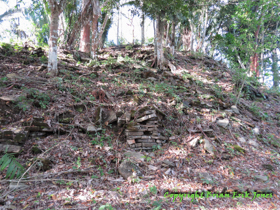
|
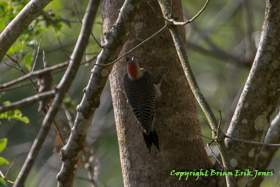
|
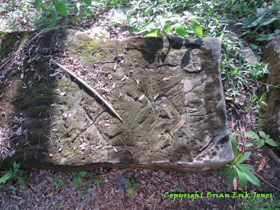
|
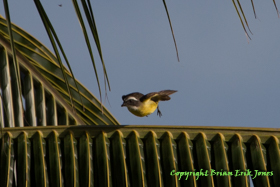
|
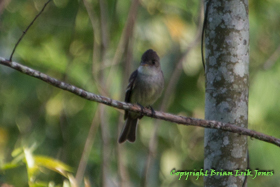
|
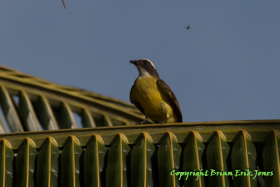
|
Uxbenka was literally a 5 minute walk from Jose's house. There wasn't much to Uxbenka, but it was still nice to visit and learn about it from a Mayan still living in the area. Jose said that other parts of Uxbenka were more interesting, but we didn't have time to visit them. We then left Uxbenka and returned to Jose's house to wait for Bruno to pick us up and take us back to Tranquility Lodge. While we talked, one of Jose's daughters kept hanging around and tried unsuccessfully to watch us without us knowing she was watching us. I suppose it's possible she hasn't seen very many white people. She was adorable.
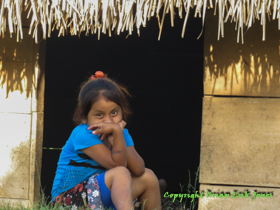
|
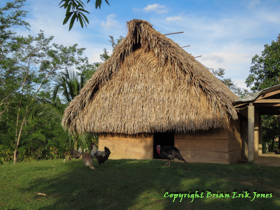
|
Back at the lodge, we discovered that the university students we had been warned about had arrived. They took up all of the rest of the accommodations at Tranquility, so we were vastly outnumbered. It turned out to not be that big of a deal until the second night they were there. They were tired tonight and after a little bit of noise, they all went to bed pretty early, so it was still peaceful.
Species list for the day:
| Species | Scientific Name | Number Seen |
Location |
| Blue-black Grassquit | Volatinia jacarina | 4 |
Santa Cruz to Yok Baluum |
| Brown Jay | Psilorhinus morio | 3 |
Santa Cruz to Yok Baluum |
| Dusky-capped Flycatcher | Myiarchus tuberculifer | 1 |
Santa Cruz to Yok Baluum |
| Great Kiskadee | Pitangus sulphuratus | 2 |
Santa Cruz to Yok Baluum |
| Melodious Blackbird | Dives dives | 5 |
Santa Cruz to Yok Baluum |
| Montezuma Oropendola | Psarocolius montezuma | 7 |
Santa Cruz to Yok Baluum |
| Olive-throated Parakeet | Aratinga nana | 8 |
Santa Cruz to Yok Baluum |
| Ruddy Ground-Dove | Columbina talpacoti | 2 |
Santa Cruz to Yok Baluum |
| Turkey Vulture | Cathartes aura | 2 |
Santa Cruz to Yok Baluum |
| White-collared Manakin | Manacus candei | 3 |
Santa Cruz to Yok Baluum |
| Crimson-collared Tanager | Ramphocelus sanguinolentus | 2 |
Uxbenka |
| Golden-fronted Woodpecker | Melanerpes aurifrons | 1 |
Uxbenka |
| Olive-throated Parakeet | Aratinga nana | 3 |
Uxbenka |
| Passerini's Tanager | Ramphocelus passerinii | 1 |
Uxbenka |
| Plain Chachalaca | Ortalis vetula | 2 |
Uxbenka |
| Social Flycatcher | Myiozetetes similis | 4 |
Uxbenka |
| Tropical Pewee | Contopus cinereus | 1 |
Uxbenka |
Districts (Intros)
| ~~~ Toledo District ~~~ | ~~~ Stann Creek District ~~~ | ~~~ Cayo District ~~~ | ~~~ Orange Walk District ~~~ | ~~~ Corozal District ~~~ | ~~~ Belize District ~~~ |
| Day 1 | Day 2 | Day 3 | Day 4 | Day 5 | Day 6 | Day 7 | Day 8 | Day 9 | Day 10 | Day 11 | Day 12 | Day 13 | Day 14 | Day 15 | Day 16 | Day 17 | Day 18 | Day 19 | Day 20 | Day 21 | Day 22 | Day 23 | Day 24 |
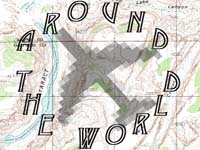 |
 |